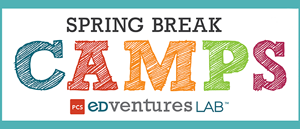The Lab Report: Bringing Engineering and Physics to Life
Project-based learning inspires students to thrive and grow using real world applications.
 It has been shown time and time again that relating concepts to the world around students is much more motivational than teaching in abstract terms (Taplin). Seymour Papert, MIT mathematician and expert on children and computing explained this theory, “we teach numbers, then algebra, then calculus, then physics. Wrong!” Papert clarified, “start with engineering, and from that abstract out physics, and from that abstract out ideas of calculus, and eventually separate off pure mathematics,” (Curtis, 2001). Papert believed that it is much better to have students at younger ages experiment with and learn engineering before branching off into more complex theories. This method not only allows younger students to dive into hands-on projects, but also encourages the cultivation of a stronger interest of STEM education.
It has been shown time and time again that relating concepts to the world around students is much more motivational than teaching in abstract terms (Taplin). Seymour Papert, MIT mathematician and expert on children and computing explained this theory, “we teach numbers, then algebra, then calculus, then physics. Wrong!” Papert clarified, “start with engineering, and from that abstract out physics, and from that abstract out ideas of calculus, and eventually separate off pure mathematics,” (Curtis, 2001). Papert believed that it is much better to have students at younger ages experiment with and learn engineering before branching off into more complex theories. This method not only allows younger students to dive into hands-on projects, but also encourages the cultivation of a stronger interest of STEM education.
 By utilizing project-based learning in the after-school and summer enrichment programs, students are immersed into STEM education while being challenged to think creatively and invent or problem-solve. Schools across the world are transitioning towards more hands-on STEM learning and, “they say, such project-based learning that freely crosses disciplines provides an education superior to the traditional ‘algebra at age nine, Civil War at ten, Great Expectations at eleven,’ structure.” Inspired by this insight, the Lab at PCS Edventures is one of the many education institutions which agrees that, “engaging students by starting with the concrete and solving hands-on, real-world problems is a great motivator,” (Curtis, 2001).
By utilizing project-based learning in the after-school and summer enrichment programs, students are immersed into STEM education while being challenged to think creatively and invent or problem-solve. Schools across the world are transitioning towards more hands-on STEM learning and, “they say, such project-based learning that freely crosses disciplines provides an education superior to the traditional ‘algebra at age nine, Civil War at ten, Great Expectations at eleven,’ structure.” Inspired by this insight, the Lab at PCS Edventures is one of the many education institutions which agrees that, “engaging students by starting with the concrete and solving hands-on, real-world problems is a great motivator,” (Curtis, 2001).
 At the Lab, our focus is to create meaningful and authentic learning experiences for students. In order to do so, we have created every project in depth to provide students with new understandings of STEM topics while encouraging students to develop important 21st Century Skills like problem-solving, thinking critically, collaborating and persisting. This month, as the excitement of their Summer season culminates with the arrival of the local fair and the beginning of school, the Lab brings engineering and physics to life in a thrilling cross-curricular challenge. Each student is given the task to develop their own flying feat, whirling wheel or rockin roller coaster while keeping in mind the different types of motion and the laws of physics.
At the Lab, our focus is to create meaningful and authentic learning experiences for students. In order to do so, we have created every project in depth to provide students with new understandings of STEM topics while encouraging students to develop important 21st Century Skills like problem-solving, thinking critically, collaborating and persisting. This month, as the excitement of their Summer season culminates with the arrival of the local fair and the beginning of school, the Lab brings engineering and physics to life in a thrilling cross-curricular challenge. Each student is given the task to develop their own flying feat, whirling wheel or rockin roller coaster while keeping in mind the different types of motion and the laws of physics.
 This week in Lab, our awesome instructors showed the students videos of modern-day fair rides to help inspire them. Students have been collaborating for multiple weeks to create an advanced roller coaster which includes wind chimes and sends metal marbles around sharp corners and fantastical loops. One student decided to improve a twirling ride he had been on the summer before. After discussing his idea with an instructor and planning out the ride, he began building. While the two fair ride challenges continue all month long, some incredible designs have started to emerge. This type of project-based learning in the Lab sparks excitement and innovation and encourages students to collaborate to create even more awesome projects. Check in with us next week to see what is going on in the Lab and in STEM education.
This week in Lab, our awesome instructors showed the students videos of modern-day fair rides to help inspire them. Students have been collaborating for multiple weeks to create an advanced roller coaster which includes wind chimes and sends metal marbles around sharp corners and fantastical loops. One student decided to improve a twirling ride he had been on the summer before. After discussing his idea with an instructor and planning out the ride, he began building. While the two fair ride challenges continue all month long, some incredible designs have started to emerge. This type of project-based learning in the Lab sparks excitement and innovation and encourages students to collaborate to create even more awesome projects. Check in with us next week to see what is going on in the Lab and in STEM education.
The Lab Report By:
Dahlton Grover
Sources:
Curtis, D. (2001, November 1). Project-Based Learning: Real-World Issues Motivate Students. Retrieved August 13, 2015, from http://www.edutopia.org/project-based-learning-student-motivation
Taplin, M. (n.d.). Teaching Values Through A Problem Solving Approach to Mathematics. Retrieved August 13, 2015, from http://www.mathgoodies.com/articles/teaching_values.html












